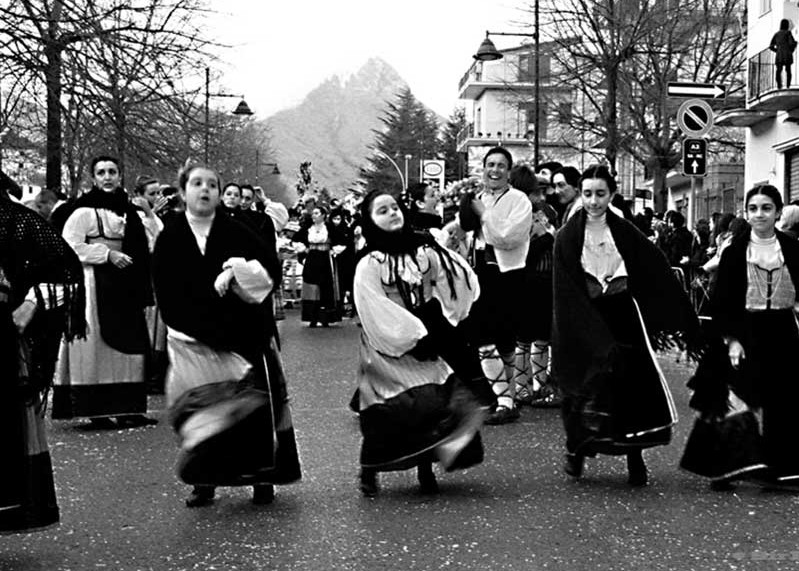
 Federazione Italiana Tradizioni Popolari
Federazione Italiana Tradizioni Popolari
Italian traditions: La Cardoleda, a popular Calabrian dance
- WTI Magazine #117 Jul 20, 2019
-

 Federazione Italiana Tradizioni Popolari
Federazione Italiana Tradizioni Popolari
According to a consolidated oral tradition, the ballad "Cardoleda", a variant of the more famous "viddhaneddha" from Reggio Calabria, would testify derivations from the ancient culture of Magna Graecia quite present in the Greek area of the Aspromonte hinterland. Therefore, "a Cardoleda" could have origins to be found in the distant roots of the Greek Dionysian dance.
Currently observing the choreographic execution of this dance, it is possible to notice how the dancers are dragged, spontaneously abandoning themselves to the rhythm; in fact, the dance assumes a symbolic liberating communicative meaning in which the forms and the choreographic steps of ancient rituals emerge. It is probable that they are the outcome of the strong process of acculturation carried out in Calabria and Southern Italy by ancient Greece. These influences could be better verified and demonstrated by a careful comparative analysis of the coreutic forms present in the Greek ceramic finds preserved in museums; other findings could be made in literary texts describing the coreutic traditions.
In all cases, in a popular context more recent to us, based on the testimonies of the elderly, the dance in Cardeto took place mainly inside the houses. The reasons for this choice were the most varied; in general, they were engagements, weddings, baptisms and other annual or family festivities. On these occasions, the front door was left open; this was a sign that everyone could participate. When this was not allowed, "u sonu" was private. This happened with the door closed, before the dances began; no one, not even the relatives, could enter the hall where the dancing took place. The dances would not start until the musicians had made a good stock of wine. U Mastru I ballu (the master of dance), a man with a strong personality and a witty eye, faciva rota, prepared the "circle" for dancing and "hunted" (invited) the woman and the dancers; in this organizational operation, it was an offence for those who felt discarded. The alleged offense exclaimed with a thunderous voice "fermu u sonu"! (stop the music).
The reaction of the "master of dance" was immediate, tagghiava u sonu (suspended the music). After complex and almost useless clarifications among the dancers, often we do not find a point of agreement; therefore, we get to fight with sticks (jasavanu). The first shot was aimed at the small light (a lumera) that, when extinguished, left everyone in the deepest darkness where they were inflicted beating from all sides (tiringhiti e tiritanghete). When these clashes did not occur, the dance proceeded joyfully with intervals of songs during which there were abundant libations of wine until the festival ended, tired. "U Mastru i ballu", so, very discreetly, had to direct the dance without benefiting anyone. Since he knew everything about everyone, he avoided inviting bitter enemies during the dance; instead, he tried to make young people dance who had looked at (jettatu l'occhiu) a beautiful girl.
U Mastru thus gave the pretender the opportunity to dance with the girl; however, this result did not occur before "u patruni da fimmina", that is, who accompanied the girl, had given his consent. Only after the approval and cordial exchange of a hint of bowing by the two guarantors, the "promessi" could dance. In several cases, the girl invited to the ball often adopted different strategies defined as ritual type. With her hands on her hips (in fianchettu) she exalted her shapes; raising her skirt a little, she attracted the attention of her suitor. The contact was made when, in the choreutic figure of the dance, the dancer on his knees made his companion turn around lifting his skirt. This figure of dance provoked applause among the onlookers and snaps of fingers that accompanied the rhythm of the music. During the young couples' dance it was usual to pronounce allusive phrases such as: "Ballunu lu palumbu e la palumba. Parùnu figghi di na sula mamma " (The pigeon and the dove dance. They look like the children of a single mother). Or, "Viva a cu balla!" Long live the dancers.
It was always "U Mastru" who, with a simple exclamation, ordered "fora u primu"! In this way, the couples were dissolved; then, the first one who had been called to dance left the place to another, who after a short round of tarantella called another young man to dance. Mixed couples could thus be formed. This situation determined a real dance challenge between the two boys. They took on bold aspects; the fingers of the hand in the imagination simulated the blade of a half-moon shaped knife; the two dancers in choreographic postures with targeted gestures mocked each other (schermiavunu). After this phase the two contenders "fought" with a step of dance called suprappedi; it is a kind of step that needed an energetic ability for the particular force released by the legs; it happened sometimes that the chestnut floors of the houses were split (schiancava). During the frantic dance, the rival dancer could be blocked by "u Mastru" with his exclamation: "Fermu l'omu!" (stop the man!); then, the dancer stopped and waited for the Mastru to order to resume the dance. The whole ritual apparatus consolidated the supremacy role of the Mastru du ballu and in this way the important social and symbolic function of his control over the choreographic struggle was imposed, expressed through the rigid rules of the dance, in which the knife is proposed through the symbolism of the fingers and not in a real way.
Capu Bastuni, as u Mastru i ballu was commonly called, had the task of inviting the dancers who adopted the same rhythm of dance and those who danced better (supra i ciuramedi) to the sound of the bagpipes. It is a more pointed dance, performed slowly and measured. Instead, others preferred to move frantically to the rapid sound of the accordion, with a furious style; there were also those who chose to dance a pedi i canzuni. During the dances there were songs di sdegnu e d’amuri. They were particular for their very dramatic interpretative force; often in the serenades, in the middle of the night, they would resound in the entire valley of Sant'Agata. At the end of the dances, a short song dedicated to the players was performed: "E dici la me canzuna vera e bona ringrazio l’organettu e cu lu sona".
Throughout the year, there were several occasions to play the instruments: during the harvest or other moments of the seasonal breaks of the main agro-pastoral activitie. The dance served as an interlude, cheering up the labors of the working days. But it was during the festivities that the people of Cardeto poured out to dance in the square and in the streets.
However, beyond the important documentation carried out by scholars, the processional processions carried out by the faithful as a promise or to dissolve vows to Our Lady of Consolation remain vital in the minds of the communities of Aspromonte. Still today, many people from Reggio remember with regret the unsurpassed dancers of Cardeto, who during a festa i riggiu were welcomed in Piazza Carmine crowded with people.
by Franco Fedele